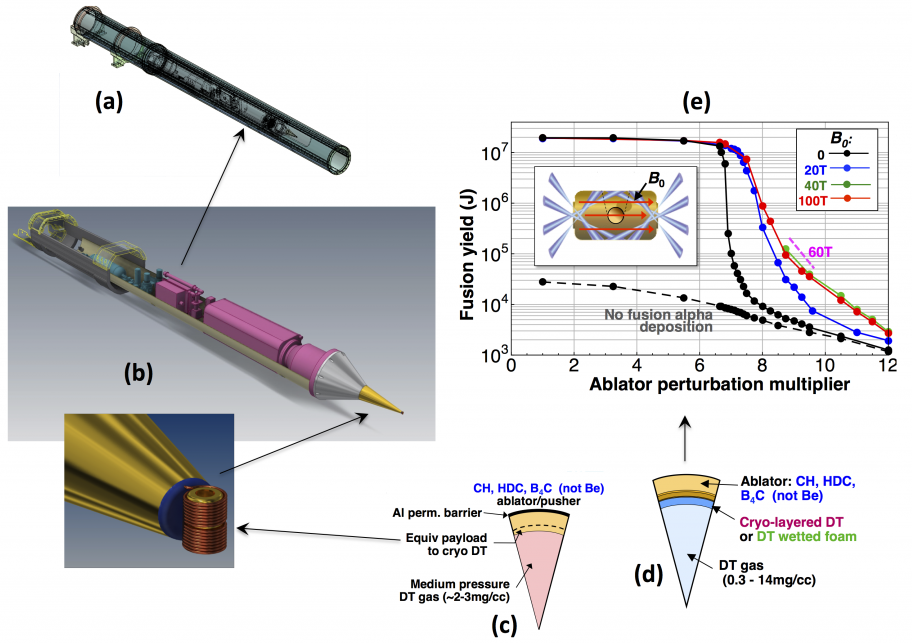L. John Perkins (14-ERD-028)
Abstract
Achieving ignition and thermonuclear burn at Livermore's National Ignition Facility (NIF) would provide data relevant to stockpile stewardship in the nuclear regime unattainable outside of an underground nuclear test. Although NIF has returned fusion data of unprecedented quality, fusion yields remain a factor of ten too low for bootstrap heating, which is the self-heating process whereby alpha particles from the deuterium—tritium reaction in the target capsule deposit their energy back into the fuel and raise the temperature, resulting in a significant increase in the thermonuclear reaction rate. Applying a seed magnetic field that would compress ignition targets to greater than 10,000 T under implosion could provide a path to ignition by relaxing the conditions required for ignition and propagating burn. Using a magnetized NIF ignition target, we will test the ability to achieve ignition in NIF capsules that would otherwise fail because of adverse hydrodynamic instabilities. We will accomplish this goal with a hohlraum hollow cylinder that has a cavity coil driven by a co-located pulsed-power supply and a deuterium–tritium gas ignition test capsule, demonstrating detectable alpha-particle heating through magnetized volumetric burn. If successful, this project will lead to the fielding of a cryogenic-layered, solid deuterium–tritium ignition capsule in NIF ignition research.
We will show that imposed magnetic fields compressed to high values under NIF implosions can significantly relax the conditions for achieving ignition. To this end, we will develop a magnetized hohlraum and an ignition gas capsule to assess fusion burn physics under high magnetic fields. Specifically, we will (1) produce an integrated design of the proposed magnetized hohlraum, the deuterium–tritium gas ignition test target, and the follow-on cryogenic-layered deuterium–tritium target; (2) design, construct, and test a pulsed-power supply and transmission line capable of supporting a 40-T axial hohlraum field; and (3) conduct proof-of-principle tests on NIF of the magnetized ignition platform to demonstrate detectable fusion alpha heating in compressed magnetic fields.
Mission Relevance
This project supports the Laboratory's mission in national and energy security by advancing NIF ignition platforms and ignition probability, improving models for predictive capability, contributing to weapons physics data, and supporting stockpile stewardship science and high-energy-density burning plasma science, as well as the strategic focus area in inertial fusion science and technology.
FY15 Accomplishments and Results
In FY15 we (1) performed initial design of a room-temperature metal-gas target that could serve as the first proof-of-principle test on NIF with a magnetic field; (2) performed two-dimensional simulations of cryogenically layered ignition targets (carbon–hydrogen and hydrogen–deuterium–carbon ablators) with HYDRA and LASNEX radiation-hydrodynamic codes, and showed an expected increase in ignition margins with imposed magnetic fields; (3) coupled the HYDRA code with the ZUMA particle-in-cell code to study hohlraum physics under an imposed magnetic field, and demonstrated reduction in capsule hot-electron preheat; (4) designed and constructed a prototype pulsed-power supply and coil system (see figure); and (5) performed initial tests of this system in our pulsed power laboratory and achieved 30-T hohlraum coil fields on our way to a nominal design goal of about 50 T (70 T maximum).
Publications and Presentations
- Perkins, L. J., et al., The application of imposed magnetic fields to ignition and thermonuclear burn on the National Ignition Facility. (2015). LLNL-PRES-663377.
- Perkins, L. J., et al., The application of imposed magnetic fields to ignition and thermonuclear burn on the National Ignition Facility. (2015). LLNL-PRES-678000.
- Rhodes, M. A., L. J. Perkins, and B. G. Logan, MagNIFico: A system for high-field magnetized inertial fusion at the National Ignition Facility. (2015). LLNL-ABS-666001.
- Rhodes, M. A., et al., MagNIFico: A system for high-field magnetized target experiments at the National Ignition Facility. (2015). LLNL-PRES-677026.
- Rhodes, M. A., et al., MagNIFico: A system for high-field magnetized inertial fusion at the National Ignition Facility. (2015). LLNL-PRES-671216.






